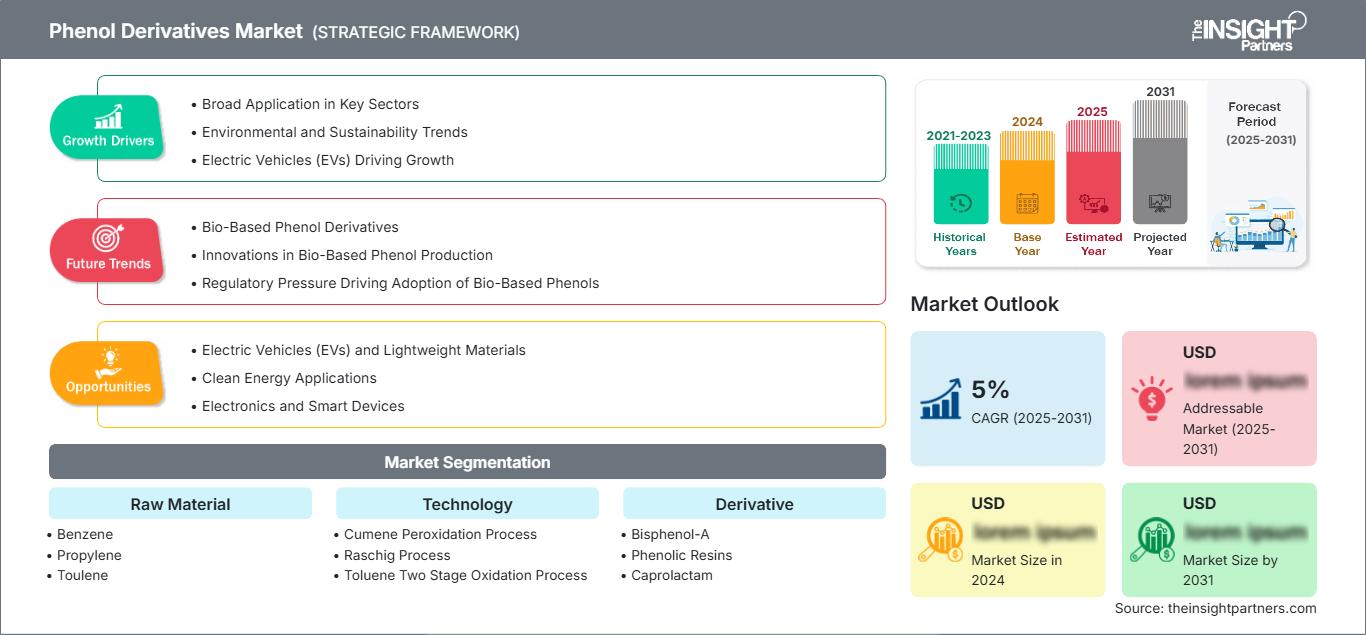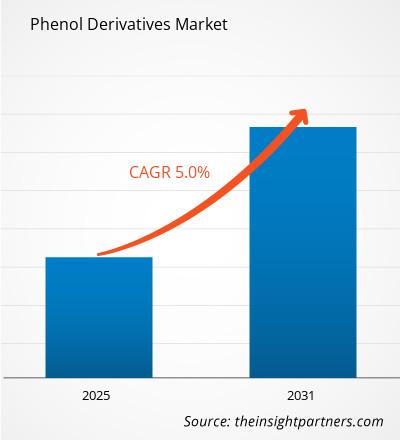Si prevede che il mercato dei derivati del fenolo registrerà un CAGR del 5% dal 2025 al 2031, con una dimensione del mercato in espansione da XX milioni di dollari nel 2024 a XX milioni di dollari entro il 2031.
Il rapporto presenta un'analisi basata sulle materie prime (benzene, propilene e toluene). Il rapporto è segmentato per tecnologia (processo di perossidazione del cumene, processo raschig, processo di ossidazione a due stadi del toluene e processo di solfonazione). Il rapporto è segmentato per derivato (bisfenolo-A, resine fenoliche, caprolattame, alchil fenolo e altri). L'analisi globale è ulteriormente suddivisa a livello regionale e per i principali paesi. Le dimensioni e le previsioni del mercato a livello globale, regionale e nazionale per tutti i principali segmenti di mercato sono trattate nell'ambito di applicazione. Il rapporto fornisce il valore in USD per l'analisi e i segmenti sopra indicati. Il rapporto fornisce statistiche chiave sullo stato del mercato dei principali attori e offre tendenze e opportunità di mercato.
Scopo del rapporto
Il rapporto "Phenol Derivatives Market" di The Insight Partners mira a descrivere il panorama attuale e la crescita futura, i principali fattori trainanti, le sfide e le opportunità. Ciò fornirà spunti a vari stakeholder aziendali, come:
- Fornitori/Produttori di tecnologia: per comprendere le dinamiche di mercato in evoluzione e conoscere le potenziali opportunità di crescita, consentendo loro di prendere decisioni strategiche informate.
- Investitori: per condurre un'analisi completa delle tendenze in merito al tasso di crescita del mercato, alle proiezioni finanziarie di mercato e alle opportunità esistenti lungo la catena del valore.
- Enti di regolamentazione: per regolamentare le politiche e le attività di controllo sul mercato con l'obiettivo di ridurre al minimo gli abusi, preservare la fiducia degli investitori e sostenere l'integrità e la stabilità del mercato.
Segmentazione del mercato dei derivati del fenolo Materia prima
- Benzene
- Propilene
- Toluene
Tecnologia
- Processo di perossidazione del cumene
- Processo Raschig
- Processo di ossidazione a due stadi del toluene
- Processo di solfonazione
Derivato
- Bisfenolo-A
- Resine fenoliche
- Caprolattame
- Alchil fenolo
Geografia
- Nord America
- Europa
- Asia-Pacifico
- Sud e Centro America
- Medio Oriente e Africa
Potrai personalizzare gratuitamente qualsiasi rapporto, comprese parti di questo rapporto, o analisi a livello di paese, pacchetto dati Excel, oltre a usufruire di grandi offerte e sconti per start-up e università
Mercato dei derivati del fenolo: Approfondimenti strategici

- Ottieni le principali tendenze chiave del mercato di questo rapporto.Questo campione GRATUITO includerà l'analisi dei dati, che vanno dalle tendenze di mercato alle stime e alle previsioni.
Fattori di crescita del mercato dei derivati fenolici
- Ampia applicazione in settori chiave: il mercato dei derivati fenolici si è sviluppato grazie alla crescente domanda in diversi settori. I composti fenolici vengono utilizzati nella produzione di materie plastiche, resine e adesivi, elementi chiave nei settori automobilistico, edile e dei beni di consumo. Questa vasta area di applicazioni stimola un'innovazione continua e nuove espansioni di capacità produttiva.
- Tendenze ambientali e di sostenibilità: oltre a questi fattori, le tendenze di mercato legate ai prodotti ecocompatibili stanno cambiando anche il modo in cui le industrie dovrebbero approcciarsi al mercato con alternative sostenibili. Pertanto, i produttori hanno iniziato a considerare fenoli e derivati di origine biologica. Ciò riflette da un lato gli obiettivi di sostenibilità globale e dall'altro attira l'attenzione dei consumatori attenti all'ambiente, aumentando così il potenziale di mercato e stimolando gli investimenti in ricerca e sviluppo per alternative più ecologiche.
- Veicoli elettrici (EV) che guidano la crescita: anche l'industria automobilistica continua a contribuire in modo significativo alla crescita di questo mercato. È necessaria una maggiore produzione di materiali leggeri e compositi avanzati per migliorare prestazioni e durata, poiché in questo settore vengono utilizzate resine fenoliche. Inoltre, con l'avvento dei veicoli elettrici, la domanda di materiali ad alte prestazioni come i derivati fenolici alimenterà ulteriormente questo mercato.
Tendenze future del mercato dei derivati fenolici
- Derivati fenolici di origine biologica: una soluzione sostenibile: tra gli sviluppi imminenti che si rifletterebbero direttamente sulle caratteristiche fenomenologiche del mercato dei derivati fenolici vi è lo sviluppo di derivati fenolici di origine biologica. Poiché le aziende sono alla ricerca di metodi più ecocompatibili per trovare fonti sostitutive alle tradizionali fonti petrolchimiche, anche le fonti rinnovabili per i fenoli di origine biologica stanno acquisendo grande importanza, non solo perché tendono a ridurre significativamente l'impronta di carbonio, ma anche perché sono perfettamente in linea con gli obiettivi di sostenibilità stabiliti dalle nazioni del mondo.
- Innovazioni nella produzione di fenoli di origine biologica: i vantaggi dello sviluppo tecnologico e dei processi in termini di innovazioni relative alla produzione di fenoli di origine biologica derivano dalla ricerca con diverse fonti di biomassa. Queste fonti includono lignina e materiali vegetali. Questi nuovi sviluppi consentono un'estrazione efficiente dei composti fenolici, il che rende i fenoli di origine biologica più sostenibili ed economicamente realizzabili rispetto ai fenoli tradizionali per molte applicazioni.
- Pressione normativa che promuove l'adozione di fenoli di origine biologica: la crescente pressione normativa per l'adozione di pratiche più ecologiche stimola la domanda di questi derivati fenolici di origine biologica. Questa tendenza è destinata a rappresentare un grande stimolo per la crescita del mercato e l'attrazione di investimenti, nonché per la collaborazione tra le parti interessate all'interno del settore chimico, poiché le aziende sviluppano prodotti sostenibili che soddisfano le preferenze dei consumatori per materiali ecocompatibili.
Opportunità di mercato per i derivati fenolici
- Veicoli elettrici (EV) e materiali leggeri: i settori emergenti stanno dando vita a nuove applicazioni che aprono enormi opportunità di crescita nel mercato dei derivati fenolici. L'industria dei veicoli elettrici sta sfruttando sempre più le resine fenoliche nella produzione di componenti per batterie e materiali da costruzione leggeri, mentre i derivati fenolici vengono utilizzati in compositi avanzati, fondamentali per migliorare la funzionalità e l'efficienza energetica dei veicoli.
- Applicazioni per l'energia pulita: il settore dell'energia pulita offre un'altra promettente opportunità, poiché i derivati fenolici vengono utilizzati anche nella produzione di pale eoliche e pannelli solari. Questi materiali possiedono un'elevata stabilità meccanica e termica, trovando quindi impiego nel rinnovamento delle fonti energetiche. Il crescente utilizzo nei dispositivi intelligenti e nella tecnologia IoT richiede anche materiali ad alte prestazioni in grado di resistere alle sollecitazioni dei componenti elettronici.
- Elettronica e dispositivi intelligenti: i derivati fenolici trovano applicazioni mediche e biotecnologiche nei sistemi di somministrazione di farmaci, negli impianti, nel packaging avanzato e nei dispositivi sanitari. Queste applicazioni sono orientate verso materiali che possiedono determinate caratteristiche come la resistenza chimica e la biocompatibilità. Esiste anche un potenziale per l'applicazione delle sostanze fenoliche nell'ambito della produzione e della prototipazione attraverso la tecnologia di stampa 3D.
Mercato dei derivati del fenolo
Le tendenze regionali e i fattori che influenzano il mercato dei derivati del fenolo durante il periodo di previsione sono stati ampiamente spiegati dagli analisti di The Insight Partners. Questa sezione illustra anche i segmenti e la geografia del mercato dei derivati del fenolo in Nord America, Europa, Asia-Pacifico, Medio Oriente e Africa, America meridionale e centrale.
Ambito del rapporto di mercato sui derivati del fenolo
| Attributo del rapporto | Dettagli |
|---|---|
| Dimensioni del mercato in 2024 | US$ XX million |
| Dimensioni del mercato per 2031 | US$ XX Million |
| CAGR globale (2025 - 2031) | 5% |
| Dati storici | 2021-2023 |
| Periodo di previsione | 2025-2031 |
| Segmenti coperti |
By Materia prima
|
| Regioni e paesi coperti | Nord America
|
| Leader di mercato e profili aziendali chiave |
|
Densità degli operatori del mercato dei derivati del fenolo: comprendere il suo impatto sulle dinamiche aziendali
Il mercato dei derivati del fenolo è in rapida crescita, trainato dalla crescente domanda da parte degli utenti finali, dovuta a fattori quali l'evoluzione delle preferenze dei consumatori, i progressi tecnologici e una maggiore consapevolezza dei benefici del prodotto. Con l'aumento della domanda, le aziende stanno ampliando la propria offerta, innovando per soddisfare le esigenze dei consumatori e sfruttando le tendenze emergenti, alimentando ulteriormente la crescita del mercato.

- Ottieni il Mercato dei derivati del fenolo Panoramica dei principali attori chiave
Punti di forza
- Copertura completa: il rapporto analizza in modo esaustivo prodotti, servizi, tipologie e utenti finali del mercato dei derivati del fenolo, fornendo un panorama olistico.
- Analisi degli esperti: il rapporto è redatto sulla base della conoscenza approfondita di esperti e analisti del settore.
- Informazioni aggiornate: il rapporto garantisce la pertinenza aziendale grazie alla copertura di informazioni e dati recenti.
- Opzioni di personalizzazione: questo rapporto può essere personalizzato per soddisfare le esigenze specifiche del cliente e adattarsi in modo appropriato alle strategie aziendali.
Il rapporto di ricerca sul mercato dei derivati del fenolo può quindi contribuire a guidare il percorso di decodificazione e comprensione dello scenario del settore e delle prospettive di crescita. Sebbene possano esserci alcune preoccupazioni valide, i vantaggi complessivi di questo rapporto tendono a superare gli svantaggi.
- Analisi storica (2 anni), anno base, previsione (7 anni) con CAGR
- Analisi PEST e SWOT
- Valore/volume delle dimensioni del mercato - Globale, Regionale, Nazionale
- Industria e panorama competitivo
- Set di dati Excel
Report recenti
Testimonianze
Motivo dell'acquisto
- Processo decisionale informato
- Comprensione delle dinamiche di mercato
- Analisi competitiva
- Analisi dei clienti
- Previsioni di mercato
- Mitigazione del rischio
- Pianificazione strategica
- Giustificazione degli investimenti
- Identificazione dei mercati emergenti
- Miglioramento delle strategie di marketing
- Aumento dell'efficienza operativa
- Allineamento alle tendenze normative




















 Ottieni un campione gratuito per - Mercato dei derivati del fenolo
Ottieni un campione gratuito per - Mercato dei derivati del fenolo